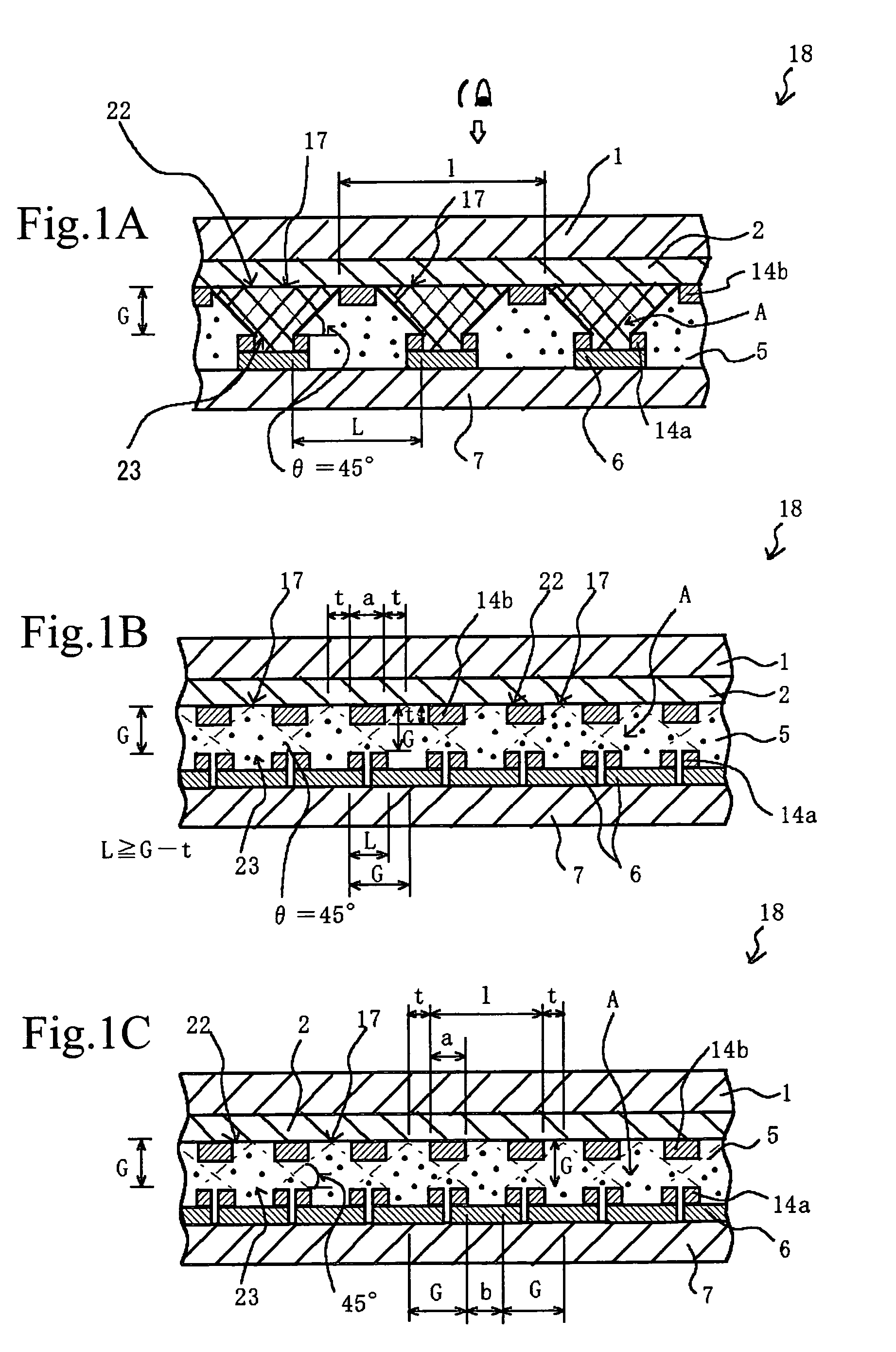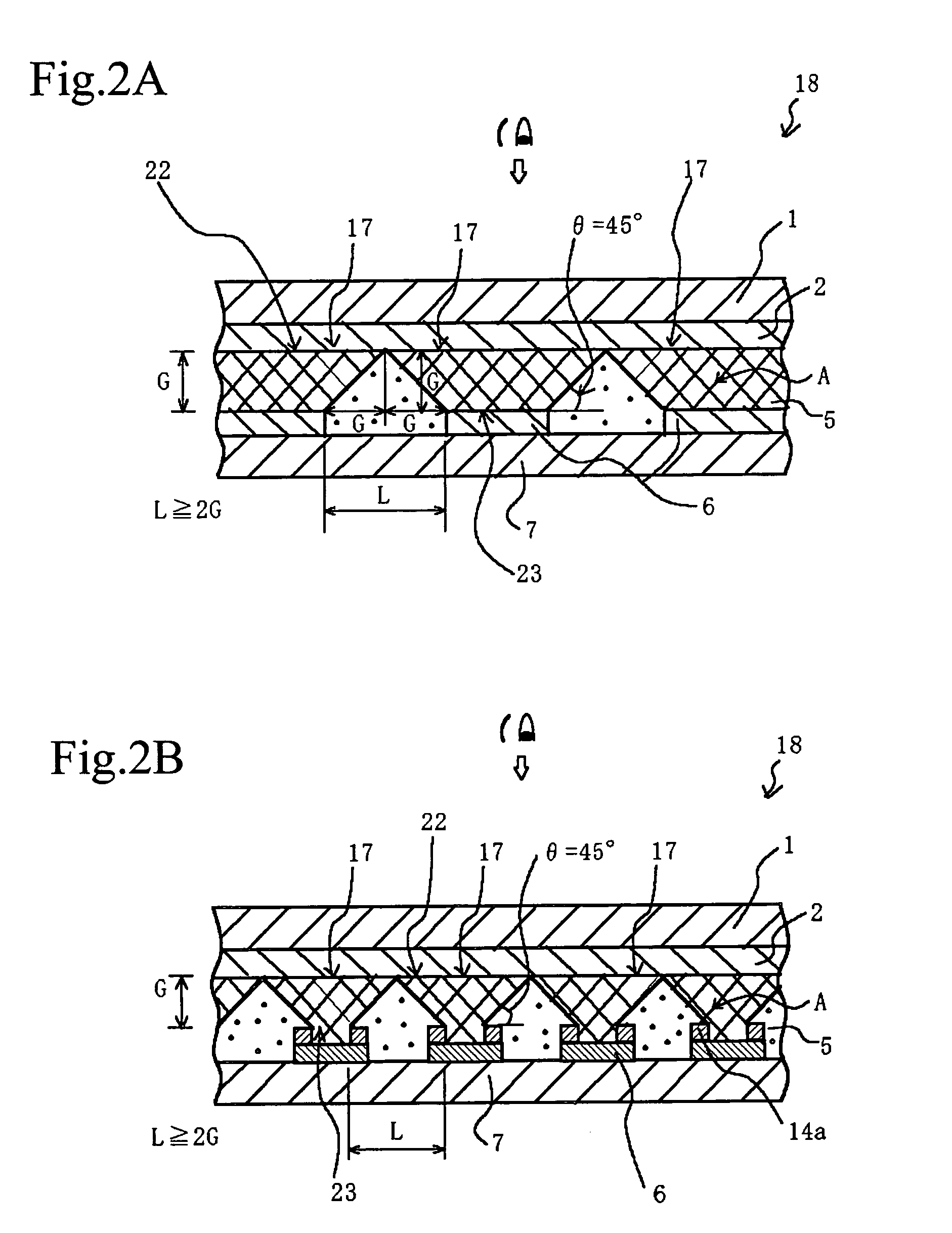Display element
a technology of display elements and elements, applied in the field of display elements, can solve the problems of limited reading sites, user fatigue, and inability to read for a long time, and achieve the effects of preventing ion diffusion range overlap, and effective preventing ions from invading adjacent pixels
- Summary
- Abstract
- Description
- Claims
- Application Information
AI Technical Summary
Benefits of technology
Problems solved by technology
Method used
Image
Examples
example 1
[0098]In the display element 18 of this example, as shown in FIGS. 1A to 1C, the insulating films 14b and 14a composed of SiO2 are disposed at the predetermined positions on both of the transparent pixel electrodes 2 and the opposing electrodes 6.
[0099]In the display element 18, the portions of the transparent pixel electrodes 2 covered with the insulating film 14b are not causative of colored display because donation and acceptance of electrons between the metal ions, which are the electrolyte, and the transparent pixel electrodes are prohibited in that portions, and so that electro-chemical deposition of the metal ions contained in the polymer solid electrolyte layer will never occur (the same will apply for the description below). The ion diffusion range A is thus restricted substantially within an area inside the insulating film 14b, and this allows the metal to deposit (or allows the coloring) only within the pixel portions 17.
[0100]Pattern of the insulating film 14b is designe...
example 2
[0119]This embodiment represents the case where the insulating film 14b is not provided at all on the transparent pixel electrode 2, as shown in FIG. 2A, and instead the distance L between the effective electrode planes of the adjacent opposing electrodes 6 is widened enough so that the individual ion diffusion ranges on the adjacent opposing electrodes 6 do not overlap with each other to thereby suppress the crosstalk, etc.
[0120]That is, in order to avoid the overlapping of the ion diffusion ranges on the adjacent opposing electrodes 6 to thereby suppress the crosstalk, etc., the range of the distance L between the effective electrode planes of the adjacent opposing electrodes 6 is defined so as to satisfy the relation of:
L≧2G.
[0121]If the relation of L6 are too close with each other, and this causes the overlapping of the ion diffusion ranges and results in the crosstalk, etc.
[0122]In the next case where only the insulating film 14a is provided on the opposing electrodes 6 side, w...
example 3
[0125]In the next case where only the insulating film 14b is provided on the transparent pixel electrodes 2 side as shown in FIG. 3A, the opposing electrodes 6 in this display element 18 are arranged so that the ions can reach the entire area of the pixel portions 17 partitioned by the insulating film 14b formed on the transparent pixel electrodes 2 without causing waste, and this brings the pixel portions 17 into a status excellent in the display efficiency.
[0126]That is, for the case where the adjacent opposing electrodes 6 come close to with each other, the distance L between the effective electrode planes of the adjacent opposing electrodes 6 should satisfy the relation of:
L≧G.
This is successful in avoiding the crosstalk between the adjacent pixels as shown in FIGS. 7A and 7B, and also avoiding color blurring or mixing.
[0127]If the relation of L6 are too close with each other, so that it is no more possible for the insulating film 14b on the transparent pixel electrodes 2 side t...
PUM
| Property | Measurement | Unit |
|---|---|---|
| reflectivity | aaaaa | aaaaa |
| drive voltage | aaaaa | aaaaa |
| angle | aaaaa | aaaaa |
Abstract
Description
Claims
Application Information
 Login to View More
Login to View More - R&D
- Intellectual Property
- Life Sciences
- Materials
- Tech Scout
- Unparalleled Data Quality
- Higher Quality Content
- 60% Fewer Hallucinations
Browse by: Latest US Patents, China's latest patents, Technical Efficacy Thesaurus, Application Domain, Technology Topic, Popular Technical Reports.
© 2025 PatSnap. All rights reserved.Legal|Privacy policy|Modern Slavery Act Transparency Statement|Sitemap|About US| Contact US: help@patsnap.com



